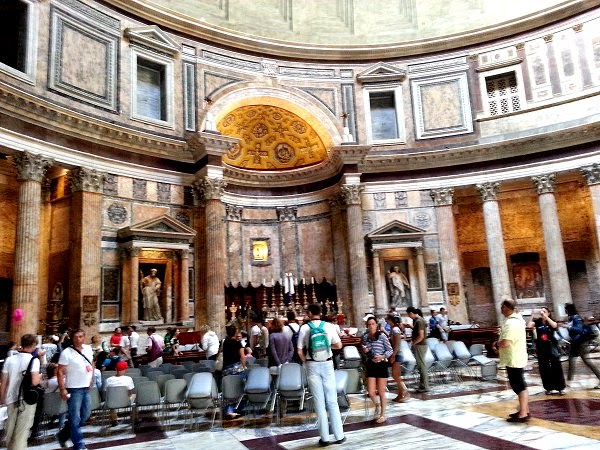"M.
AGRIPPA.L.F.COSTERTIUM.FECIT”
“Marcus Agrippa son of Lucius, having been consul three times made it”.
“Marcus Agrippa son of Lucius, having been consul three times made it”.
The Pantheon does has had an extraordinarily chequered history... Restored by Septimius Severus in 202, it was then abandoned under the first Christian emperors and pillaged by the Goths when they invaded Rome. Then in 608 the Byzantine emperor Phocas donated the temple to Pope Boniface IV, who consecrated it as a Christian church.
In 667, on a 12 day stop-over in Rome, Constans II stripped it bare, taking away the gilded bronze tiles that covered the roof ( these were replaced by lead in 735 ). And later still it was used as a fortress.
During the Renaissance period it was restored and enjoyed a grand new life as a church to be greatly admired. Pius IV recast the bronze doors in 1563, although in 1625 Pope Urban VII melted down the bronze ceiling of the portico for Bernini to make his famous baldachin ( canopy over the high altar ) in St Peter's plus 80 cannons for Castel SantAngelo ( ... see previous blogs ... ).
The Pantheon is probably most prized for the "revolutionary" techniques used in its construction. The height and the diameter of the interior are the same ( 43.3m ) giving the impression of a spherical space. The diameter of the dome - the largest masonry vault ever built - exceeds by more than 1m that of St Peter's. It is cast of concrete and volcanic stone to make it lighter. The five rows of coffers that articulate its surface were once decorated with gilded rosettes. The cylindrical drum - made of brick and concrete - is 6m thick. It is hard to imagine this building method took place nearly 2000 years ago - and has stood the test of time since ... !!!
The concrete for the dome was poured in moulds,
probably mounted on temporary scaffolding -
the oculus is the main source of natural lighting
and is open to the weather.
The Pantheon is a working church ...
dedicated to Saint Mary and the Martyrs.
dedicated to Saint Mary and the Martyrs.
... padre della patria ...
The tomb of Victor Emmanuel II- d.1878
first king of the united Italy - known as the "Father of the Fatherland"

Tomb of Umberto the First ... d.1900
King of Italy - and commonly known as ... !!! ...

Tomb of Umberto the First ... d.1900
King of Italy - and commonly known as ... !!! ...
by the Grace of God, King of Italy, King of Sardinia,
Cyprus, Jerusalem, Armenia, Duke of Savoy, count of Maurienne, Marquis
(of the Holy Roman Empire) in Italy; prince of Piedmont, Carignano,
Oneglia, Poirino, Trino; Prince and Perpetual vicar of the Holy Roman
Empire; prince of Carmagnola, Montmellian with Arbin and Francin, prince
bailliff of the Duchy of Aosta, Prince of Chieri, Dronero, Crescentino,
Riva di Chieri e Banna, Busca, Bene, Brà, Duke of Genoa, Monferrat,
Aosta, Duke of Chablais, Genevois, Duke of Piacenza, Marquis of Saluzzo
(Saluces), Ivrea, Susa, del Maro, Oristano, Cesana, Savona, Tarantasia,
Borgomanero e Cureggio, Caselle, Rivoli, Pianezza, Govone, Salussola,
Racconigi con Tegerone, Migliabruna e Motturone, Cavallermaggiore,
Marene, Modane e Lanslebourg, Livorno Ferraris, Santhià Agliè, Centallo e
Demonte, Desana, Ghemme, Vigone, Count of Barge, Villafranca, Ginevra,
Nizza, Tenda, Romont, Asti, Alessandria, del Goceano, Novara, Tortona,
Bobbio, Soissons, Sant'Antioco, Pollenzo, Roccabruna, Tricerro, Bairo,
Ozegna, delle Apertole, Baron of Vaud e del Faucigni, Lord of Vercelli,
Pinerolo, della Lomellina, della Valle Sesia, del marchesato di Ceva,
Overlord of Monaco, Roccabruna and 11/12th of Menton, Noble patrician of
Venice, patrician of Ferrara.
Tomb of the great Renaissance architect and painter
Raphael ( d 1520 ) and his fiance Maria Bibbena.
City pollution and the weather are taking their toll ...
... as are the constant movement and touching of the tourists ...
... ooops - and did I mention those dreaded tour groups ...
A magnificent temple for all the gods and goddesses to share ...






















No comments:
Post a Comment
Note: Only a member of this blog may post a comment.